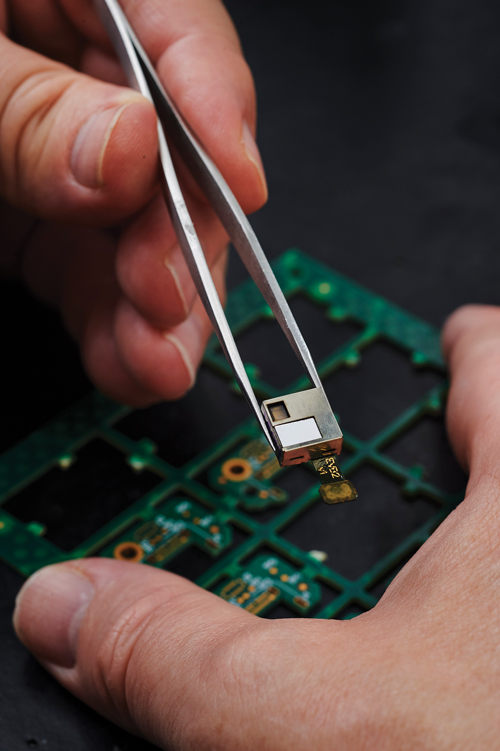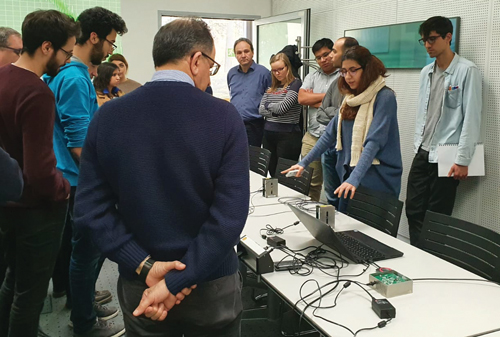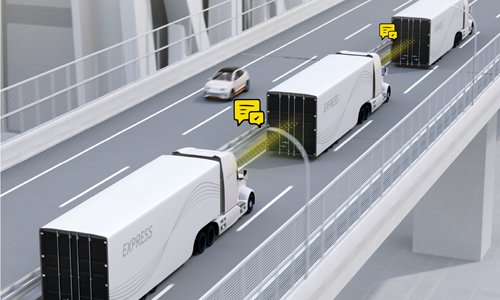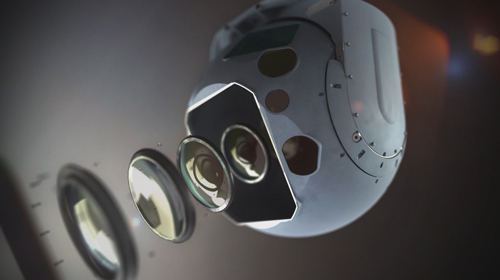In 2011, Harald Haas revealed a technology that would see light-based wireless data pouring from our lightbulbs, yet more than a decade later few have seen it in action. Haas gave a talk at the TEDGlobal conference that introduced LiFi communication, whose recording now has 2.7 million views. In it, Haas noted that the optical spectrum is more than three orders of magnitude wider than the entire radio spectrum used for existing wireless communications. ‘People in the meantime have always asked, “Okay, if there’s so much resource, why don’t we see these very high data rates?”,’ Haas, who is now at the University of Strathclyde, Glasgow, told Electro Optics. ‘That is primarily down to the availability of devices.’
One critical advance is that LiFi developers have recently added lasers rather than just LEDs to their products. ‘The modulation speed of LEDs is limited by the nature of the semiconductor device,’ explained Joël Thomé, CEO of the Vénissieux, France-based photonic innovation centre Piseo. Piseo is also a partner of France-based semiconductor market analysis company Yole Développement. Thomé highlighted vertical cavity surface emitting lasers (VCSELs), which turn off and on at much higher frequencies than LEDs, meaning they can encode more data. ‘However, their power is generally low, especially in the near infrared wavelengths, and they require caution to prevent eye hazards,’ Thomé added.
Such limitations presented an opportunity for Goleta, California-headquartered Kyocera SLD Laser. It has developed ‘safe, high luminance’ white laser lighting, explained Paul Rudy, the company’s chief marketing officer and co-founder. Kyocera SLD Laser is vertically integrated, founded on GaN semiconductor edge-emitting blue laser technology developed by Rudy, James Raring, Steve Denbaars and 2014 Nobel Laureate in Physics Shuji Nakamura. Combined with phosphors, these lasers generate white light intended specifically for general lighting. While developing lighting products, the company was also demonstrating its visible and infrared sources’ LiFi communication capabilities. ‘It’s all come together in the last five years or so,’ Rudy said.
Likewise, several other organisations are helping make devices available to deliver on LiFi’s promise. Meanwhile, demand for wireless data is growing rapidly to levels where radio-based wireless technology might struggle. Could LiFi therefore finally be near widespread adoption? To reach its potential, LiFi must also overcome the challenge posed because light travels in a particular direction, whereas radio frequency (RF) signals such as WiFi travel in all directions. ‘It is more difficult to capture the light signal if you are not directly under or in front of it,’ Thomé said. He said that LiFi can supplement WiFi in ‘specific applications where the use case is well demonstrated’. ‘So far, we hardly see any reason why LiFi should replace the incumbents such as radio-based and cable solutions,’ Thomé explained. For consumer markets to adopt LiFi, it must work as well as WiFi at the same cost, Thomé said.
Ready for take-off?
Yole and Piseo noted that the most-discussed opportunity for LiFi has been in aircraft, supplying data to devices in individual passengers’ seats for streaming entertainment experiences. ‘Although not yet commercially deployed, there are currently a lot of efforts in LiFi development projects in this market,’ Thomé said. ‘So far, we expect an expansion in niche markets where LiFi can demonstrate its added value. This is the case in aeroplanes for entertainment applications, where there is much to gain in cost and weight.’
One company that has tested this application is Edinburgh-headquartered PureLiFi, co-founded by Haas. However, PureLiFi chief executive officer, Alastair Banham, noted that the aircraft industry has suffered significantly in the last two years because of the pandemic. ‘It’s not a volume play in aircraft today,’ Banham said, though it will be an opportunity in future.
Instead, PureLiFi claims the LiFi industry’s most significant deployments to date, in two multi-million dollar deals with the US Army. The deals are for PureLiFi’s Kitefin product, which provides highly secure communication in both tactical and enterprise centres. An example might be in a tent when the army is doing field exercise. ‘Assembling and disassembling the Kitefin system is very fast,’ said Banham. And as it isn’t giving off radio signals, the US Army tried and failed to detect and jam its communications. ‘LiFi cannot be detected outside the space that is covered by opaque materials,’ stressed Banham. ‘It has a low probability of detection and interception.’ It also isn’t limited by local licensing that defines the radio spectrum regions used for communication.
In February 2022, PureLiFi launched a home-focused LiFi ecosystem, aptly named LiFi at Home. One of its two key components is an access point downlighter that fits into standard GU10 lightbulb fittings. The other key component is a light antenna module that is smaller than camera modules found in smartphones today. At the Mobile World Congress in Barcelona, Spain, PureLiFi demonstrated a system with light antennae integrated into a smartphone, a TV, and a Microsoft Hololens augmented reality headset. LiFi at Home also includes a powerline communication system that enables data to move from one room to another through a house’s electrical wiring.

PureLiFi wants to encourage electronics manufacturers to integrate light antennae into their products. Credit: PureLiFi
PureLiFi intends to certify and commercialise the LiFi at Home products, Banham said. Yet the Mobile World Congress demonstration also sought to encourage electronics manufacturers to integrate light antennae into their products. PureLiFi works with optical component manufacturing partners, who produce custom-designed transceivers. This involves a mixture of both bespoke lasers and LEDs spanning the visible and infrared light spectrum. ‘We’re a company that will design and develop products that we ship and design-in to OEMs that will use devices in LiFi products,’ Banham said.
Multiple pathways
Kyocera SLD Laser’s Rudy stressed the need for devices well-suited to LiFi. ‘We have our laser light sources in automotive headlights, in flashlights being sold on Amazon,’ he explained. ‘It’s a laser-based light source. But it’s class one with respect to safety, so it can essentially be treated like an LED. This laser light is very high brightness, and it retains the high-speed capability.’ That brightness has enabled the company to transmit LiFi data over ranges up to 50 metres.
Rudy also noted that the company’s lasers emit light over narrow colour ranges, spanning wavelength linewidths of one or two nanometres. That enables Kyocera to multiplex many slightly different colours together, using each as a separate data channel. ‘We have hundreds of nanometres available to us, so we’re really just getting started,’ Rudy said.
Integrating this technology into devices like laptops starts with dongles, connecting via a USB port, for example, Rudy explained. ‘Ultimately, it will get deployed into consumer electronics,’ he said. ‘These are photon detectors and photon transmitters that are common already. It is notable that Kyocera does have a mobile handset group and has such a strong communications presence globally as a critical part of its $25 billion revenue streams. So, we’re looking at this step by step; we’ll become more integrated as we go.’
Rudy highlighted smart factories as another potential lead application. Laser-based LiFi can take the large volumes of data needed to and from ‘the workstations, the people, the vehicles, and, of course, the robot workstations, measuring, optimising, and controlling everything’, said Rudy. ‘With RF data rates, it’s just very challenging, so we think laser LiFi is an ideal solution.’

Sepideh Kouhini demonstrates the LiFi technology she is developing at Fraunhofer HHI. Credit: Fraunhofer HHI
Sepideh Kouhini from the Fraunhofer Heinrich Hertz Institute (HHI) in Berlin, Germany, has been developing LiFi systems for smart manufacturing. One area she’s focused on is overcoming the blockage and shadowing vulnerabilities that Thomé highlighted using multiple-input multiple-output (MIMO) approaches. Kouhini noted that MIMO is well-known for enhancing reliability and adding capacity in RF communication. The distributed MIMO systems she works on include a central unit in charge of performing signal processing and separating the signal, feeding it towards several ceiling-mounted distributed units (DUs) via plastic optical fibre.
‘The ceiling-mounted devices contain four high-power LEDs and five photodiodes each equipped with its trans-impedance amplifier,’ Kouhini explained. ‘The idea is to make the DUs more powerful and more sensitive and thereby shift part of the power consumption from mobile units (MUs) to DUs at the ceiling where power is available. Current MUs for LiFi are handheld devices, which typically have an optical front-end pointing upwards, and full baseband processing with a USB or Ethernet interface.’ If one path between an MU and DU is blocked or shadowed, the MIMO approach means that other paths are available.
From factories to homes
For smart manufacturing, precise positioning information is vital, and could be a unique feature of LiFi, thanks to how light propagates, Kouhini noted. LiFi signals experience no electromagnetic interference and few reflections, she said, which are challenges faced by radio-based positioning technologies. As such Fraunhofer HHI has recently developed a LiFi positioning system focused on Industry 4.0 applications. Kouhini also asserted that ‘the LiFi front ends developed by Fraunhofer can provide higher throughput at larger distances besides providing broader coverage compared to other competitors.’ In February 2021, such capabilities enabled Japanese mobile communications infrastructure provider Sangikyo Corporation to use Fraunhofer HHI’s LiFi technology to connect three driverless trucks into a platoon driving together.

In February 2021, Japanese mobile communications infrastructure provider Sangikyo used Fraunhofer HHI’s LiFi technology to connect three driverless trucks into a platoon driving together. Credit: Fraunhofer HHI
Today’s LiFi systems also benefit from specifically developed technologies to modulate the light and encode data into it. Much of Haas’ research over the past two decades has been on optimising orthogonal frequency division multiplexing (OFDM), which can enable LiFi to be used in sunlight. LiFi can also use adaptive modulation, so that if there is a good connection it can send more data; if there is a poor connection, such as light only reaching receivers via reflections, maintaining a connection with lower data rates. ‘It will also work with non-line of sight components and reflection,’ said Haas.
Haas highlighted that Kyocera SLD’s technology can use this kind of modulation to send multiple data streams in parallel on different wavelengths. At the Consumer Electronics Show in Las Vegas, Nevada, in January 2022, the company demonstrated a LiFi system in which 10 different wavelengths transmitted independent data. The system now delivers greater than 100Gb/s, a data rate 100 times faster than the 5G wireless protocol. ‘And it’s only 10 wavelengths, so it is possible to scale the data rate to even higher numbers if devices with more wavelengths are available,’ Haas said.
To push LiFi further, the main challenges are standardisation, cost, and wide adoption by the telecommunication players, from device to infrastructure, and the benefits of LiFi must surpass incumbent solutions, Thomé said. ‘The key questions we should ask ourselves concerning new technologies or techniques are: “What problem do they solve from the user perspective?”,’ Thomé added.
PureLiFi is leading standardisation efforts, with the IEEE 802.11bb standard for light communications due to be ratified before 2022 ends. PureLiFi’s goal is to enable its light antenna to connect directly to the baseband processors that currently manage radio wireless networking capabilities. ‘That would make it a lot easier for us to design-in to devices,’ Banham said. The new standard’s goal is full interoperability, he added, enabling a LiFi-enabled smartphone to seamlessly transition to WiFi or 5G when you put it in your pocket.
Meanwhile, Haas stressed that LiFi can solve the problem of rapidly increasing data demand. ‘We talk about augmented and virtual reality with a 360˚ experience,’ he said. ‘There is a huge data requirement.’ Haas noted that some people propose terahertz-frequency wireless communications as a solution to this problem, but no commercially mature devices exist. ‘There is a very good additional solution for wireless connectivity using the optical spectrum. These devices exist, they are qualified, and they can be used to deliver tens of gigabits per second. That opens huge opportunities to drive our digital connected world.’
Kouhini considers LiFi’s potential and maturity to be proven, but the technology must become better known and understood for widespread adoption. ‘One of the main obstacles to adopting LiFi is to find sectors that are willing to invest in innovative technologies,’ she said. Nevertheless, LiFi has great potential, Kouhini underlined. ‘I am looking forward to using it in my apartment in the near future.’
Sponsored: Free-Space Optical Communications
Increasing optical efficiency and accuracy while lightening the load for free-space optical communications
‘Imagine using a laser pointer to highlight an object on a presentation, but the presentation is on a screen thousands of kilometres away,’ said Reg Jonas, technical manager for optics at Raytheon ELCAN, a division of Raytheon Intelligence & Space. ‘That’s the challenge with free-space optical communications. Optical efficiency and point-to-point accuracy become critical factors when distances between transmitter and receiver become so large.’
What is Free-Space Optical Communication (FSO)?
FSO is a point-to-point technology that uses light to transfer data. ‘Free-space’ refers to the use of air or a vacuum as a transmission medium rather than the use of a fibre optic cable. While fog and clouds are disadvantages for terrestrial FSO, the vacuum of space offers new opportunities but also poses its own challenges.
‘Lighter and smaller is always a challenge,’ said Jonas. ‘Lighter, smaller and more robust have traditionally been mutually exclusive. However, technology is helping us overcome these barriers and push the boundaries.’
More than the sum of its parts
Sometimes the most obvious solution isn’t the best choice. Mirrors gather and focus light. For infrared optics, mirrors are typically made of aluminium because it’s lighter than glass. But it’s also harder and more costly to create a smooth surface on aluminium. Raytheon ELCAN developed an alternative approach to create lightweight mirrors for space. ‘A human hair is 80 microns across,’ said Wolf Glage, Raytheon ELCAN engineering vice president. ‘We’re working to achieve sub-micron surface finishes that will improve performance and reduce weight of the payloads launched into space. We know how to achieve this with glass.’

Raytheon ELCAN delivers high precision, high efficiency optics for challenging environments for military, industrial and commercial applications. (Image:Shutterstock: sdecoret)
By strategically removing material from the backing rather than using a solid piece of glass, ELCAN reduced the weight of a single mirror from 7 pounds to 4.5 pounds with no loss of performance. This created a cost-savings of more than $100,000 for a single three-mirror system being sent into low-Earth orbit.
High-reflectivity mirrors for FSO
A commercial bathroom mirror may reflect about 90 per cent of incident illumination. With limited power on a satellite payload, a steering mirror for ISL (intra-satellite link) requires a reflection efficiency greater than 99.9 per cent. This is made possible with dielectric coatings.
‘Leveraging the combination of our technologies, tools and experience, we can precisely deposit optical coatings to optimise optical performance and simultaneously achieve required environmental durability to satisfy the extreme requirements of space,’ said Daniel Puzzo, PhD and lead thin film coating designer at Raytheon ELCAN.
High-reflectivity mirrors can also be used in reflective optical telescopes and beam -steering mirrors required for fine-pointing or point-ahead mechanisms for other aerospace and defence applications. For infrared laser applications, thin film coatings are applied to IR optical substrates in extremely thin layers – sometimes only a few nanometers thick. These coatings, which might include hundreds of layers, control the transmission and reflection of light through the system, reducing scatter and increasing the optical performance. Coatings can protect lenses, prisms or domes made of high-transmittance infrared materials that are too soft to withstand the environmental effects if left uncoated.
‘Chasing microns’
‘If you were to take a pair of glasses and shift them about an inch sideways either way, you’re going to get distortions,’ said Tony Brinovec, business development manager for space at Raytheon ELCAN. ‘You want your eye to look through the centre of that lens. As you get into precision optics, you need to make sure the optical axis, which is like an imaginary line right through the middle of the system, is as perfect to the centre as possible. If some of the elements are not centred correctly, the system isn’t going to work properly.’

Thin film coatings, which might include hundreds of layers, protect lenses, prisms and domes that are unable to withstand environmental effects if left uncoated. Credit: Raytheon ELCAN
A common unit of measurement in optics is the micron – one millionth of a metre. Five microns is about 1/20th the thickness of a sheet of paper. In high precision optical systems, even a few tiny microns can make an enormous difference. Troubleshooting to achieve this level of precision is known as ‘chasing microns’ and it’s important in everything the company does.
Raytheon ELCAN knows that microns matter when it comes to their optical systems. That’s why the company invests in partnerships and in research and development to improve the precision of its optical systems so that it can help customers see better and farther, even from miles above the Earth.
‘Recent enhancements in design and process engineering along with investments in manufacturing and metrology are allowing us to push the boundaries of our existing portfolio,’ said Puzzo. ‘Now we’re challenging our customers to tell us what they need as opposed to them asking us what we can make.’
About Raytheon ELCAN
Raytheon ELCAN is a vertically integrated optics innovation centre specialising in technologically sophisticated and superior-quality optical solutions that meet strict military and commercial specifications. Raytheon ELCAN offers superior design and engineering capabilities, proprietary production technologies and fully integrated manufacturing to provide custom, turn-key solutions.
Further information
Learn more at: www.rtx.com/ELCAN
Visit Raytheon ELCAN at Laser Munich Hall B5, Booth #447


